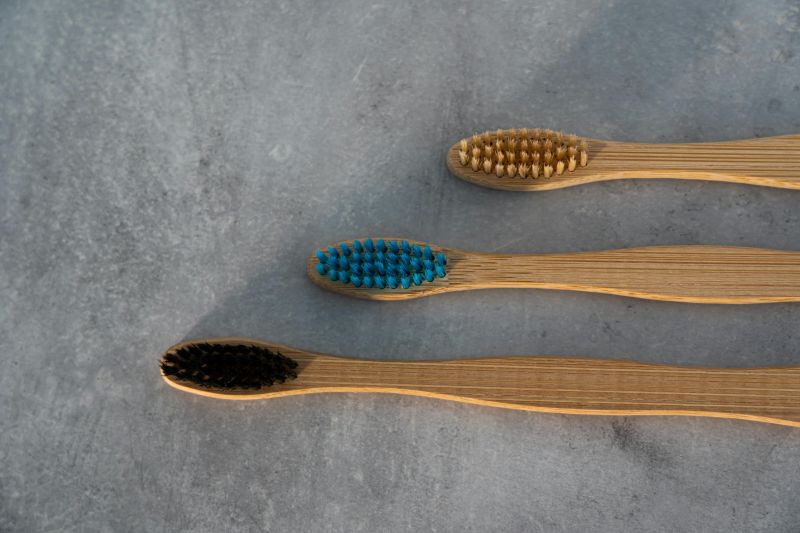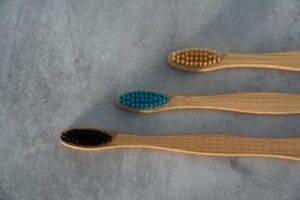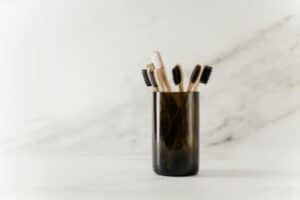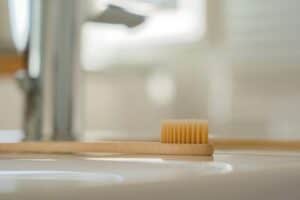
29 Aug How Often Should You Replace Your Toothbrush?
A toothbrush is your first line of defense against tooth decay, gum disease, and bad breath. But just like anything used daily, it doesn’t last forever. So, how often should you replace your toothbrush to keep your oral health in top shape?
In this article, you’ll learn when and why it’s essential to swap your toothbrush, how bacteria can quietly build up, and what signs to look out for. We’ll cover all the expert advice you need to maintain a healthier, brighter smile—starting with your brush!
Why Toothbrush Replacement Matters
Toothbrushes do more than move toothpaste around—they scrub away plaque, food debris, and bacteria. But over time, their bristles wear down, making them less effective. That’s when problems like gingivitis, tartar, and cavities can sneak in.
Studies show that an old, worn-out toothbrush removes significantly less plaque compared to a new one. What’s worse? Frayed bristles can even irritate your gums and wear down enamel.
Following expert guidance helps ensure your brushing routine is doing what it’s supposed to: protecting your smile.

The Ideal Frequency for Replacement
So, how often should you replace your toothbrush?
According to the American Dental Association (ADA), you should replace your toothbrush every three to four months, or sooner if the bristles look worn out. However, not everyone uses their toothbrush the same way. If you tend to brush with a lot of pressure or have a particularly vigorous routine, your bristles may wear out much faster, making a two-month replacement cycle more realistic.
Electric toothbrush users should pay even closer attention. Because their heads move faster and often apply more pressure, their bristles can wear out quicker, requiring replacement every two to three months.
For kids, the replacement schedule is even more frequent. Children often chew on their brushes or press too hard while brushing. That’s why dentists recommend changing a child’s toothbrush every two to three months—or earlier if you notice fraying or damage.
Signs It’s Time to Replace Your Toothbrush
While marking your calendar is helpful, your toothbrush will often tell you when it’s time for a replacement.
Look out for signs like bent, splayed, or frayed bristles. Once the bristles start to fan outward, they can no longer clean effectively. You might also notice that the color of the bristles has faded or the brush has developed a mild odor—even after rinsing it thoroughly. That’s a red flag.
If you’ve recently been ill—especially with something contagious like the flu, strep throat, or COVID-19—it’s smart to toss your toothbrush immediately after recovery. Lingering bacteria or viruses can lead to reinfection.
Also, any visible mold or dark spots on the brush handle or base? That’s your cue to replace it right away.
Manual vs. Electric Toothbrush Lifespan
Both manual and electric toothbrushes get the job done—but how long they last differs slightly.
Manual toothbrushes generally last around three to four months if you brush twice daily with moderate pressure. On the other hand, electric toothbrush heads often need replacing more frequently—every two to three months—because they operate at high speeds and cover more surface area, which wears out bristles faster.
The misconception is that electric brushes, being more high-tech, last longer. In reality, their heads tend to wear out just as fast, if not faster. Always consult the manufacturer’s guidelines for your electric brush model to stay on top of maintenance.
Also, consider the price: electric replacement heads are usually more expensive than buying a new manual toothbrush. However, the added cleaning efficiency can make the cost worth it.
Impact of Germs and Bacteria
Even if your toothbrush looks clean, it could be crawling with bacteria. Every time you brush your teeth, the bristles pick up microbes from your mouth. On top of that, storing your toothbrush in a humid bathroom allows airborne germs and mold spores to latch on and multiply.
Some of the most common culprits found on toothbrushes include Streptococcus mutans (a major player in tooth decay), E. coli, and even Candida, a type of yeast. Over time, these microorganisms build up, turning your toothbrush into a petri dish.
That’s why storing your brush upright in a well-ventilated space is essential. Avoid using airtight or closed containers unless you’re traveling—and if so, be sure to let the brush dry completely before sealing it.

How Toothbrush Wear Affects Cleaning Effectiveness
You may not realize just how big a difference worn-out bristles make. Research shows that brushes with frayed or bent bristles remove up to 40% less plaque than new ones. That’s a major reduction in effectiveness, especially considering plaque buildup is the leading cause of cavities and gum disease.
When bristles lose their original shape, they can no longer reach the small crevices between your teeth or along the gum line. The result? You leave behind harmful bacteria, no matter how well or how long you brush. Plus, worn bristles are more likely to irritate your gums, leading to redness, swelling, and sensitivity.
So don’t wait until your toothbrush looks like a miniature broom—by then, it’s well past time for a replacement.
How Illness Affects Toothbrush Hygiene
When you’re sick, your body is battling viruses or bacteria. But your toothbrush is soaking up those same germs with every use. Once the illness passes, it’s tempting to just rinse the brush and keep using it—but that’s risky.
Infections like the flu, cold, COVID-19, or even a sore throat caused by streptococcus bacteria can linger in the bristles for days. Reusing the same toothbrush can reinfect you or spread germs to others if your brushes are stored close together.
As a general rule, replace your toothbrush after any illness—especially if it involved your respiratory tract or mouth.
Kid’s Toothbrush Replacement Guidelines
Children’s oral hygiene needs differ from adults in more ways than one. First, they tend to be more aggressive brushers. Second, they often bite or chew on the brush head—something adults rarely do. That combination means children’s toothbrushes wear out faster.
For most kids, toothbrushes should be swapped out every two to three months, or sooner if you notice fraying or damage. If your child has recently been sick, follow the same protocol as adults and replace the brush immediately.
Also, make brushing fun and part of a routine. Letting kids choose their own new toothbrush can make the replacement process something they look forward to instead of resist.
Mistakes People Make with Toothbrushes
Even with the best intentions, many people make simple mistakes that reduce their toothbrush’s effectiveness or lifespan.
One of the most common errors is storing a toothbrush in a closed container. While it may seem more hygienic, it actually creates a moist environment that encourages bacterial growth.
Another mistake is using too much pressure when brushing. This not only wears down bristles prematurely but can also damage your gums and enamel.
Some people also make the mistake of sharing toothbrushes or letting the heads of different brushes touch in a shared holder—both of which increase the risk of cross-contamination.
Finally, many people don’t rinse their brushes properly after use. Leaving bits of toothpaste and food particles in the bristles only accelerates bacterial buildup.

How to Properly Store Your Toothbrush
Storing your toothbrush properly helps extend its life and keeps it clean.
The best way to store it is upright in an open holder, away from other brushes. Letting it air-dry naturally is crucial, as moisture breeds bacteria. Make sure it’s not touching other toothbrushes to avoid cross-contamination, especially in shared bathrooms.
If you travel, it’s fine to use a protective cap—but always dry the toothbrush thoroughly first. Once your trip is over, replace the brush if it’s been stored wet for an extended period.
Toothbrush Alternatives and Tools
While the traditional toothbrush works great for most people, there are situations where alternative tools can help improve oral hygiene.
For example, interdental brushes are excellent for people with braces or closely spaced teeth. Tongue scrapers can help eliminate bacteria that cause bad breath. Disposable toothbrushes are convenient for travel or emergency use, and toothbrush sanitizers that use UV light offer added protection for those worried about bacterial buildup.
These tools shouldn’t replace a toothbrush altogether—but they can complement your daily routine.
Eco-Friendly Options for Replacement
Replacing your toothbrush doesn’t have to mean harming the environment.
Today, many brands offer sustainable options, like bamboo-handled brushes that biodegrade faster than plastic. Some toothbrushes come with replaceable heads, so you only discard the top portion rather than the whole thing.
Also, check if your local recycling program accepts toothbrushes or partner with initiatives like TerraCycle, which runs specialized recycling programs for oral care products.
Making the switch to eco-friendly options is a small but impactful way to care for the planet while caring for your teeth.
Choosing the Right Toothbrush
Choosing the right toothbrush starts with looking for the ADA Seal of Acceptance, which guarantees it meets quality and safety standards.
Go for soft bristles, as they’re gentler on your gums and just as effective as harder ones when used correctly. The head size should be small enough to reach all areas of your mouth—especially the back molars.
A comfortable, non-slip handle also helps improve control, making brushing more effective. Whether you prefer electric or manual, tech doesn’t matter as much as technique—but using the right brush certainly helps.
Conclusion + Final Tips
Replacing your toothbrush is a simple habit that pays off in a big way. Your brush does the heavy lifting in your daily hygiene routine—but only if it’s in top shape.


Sorry, the comment form is closed at this time.